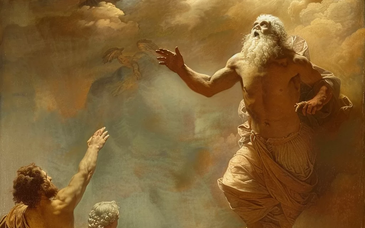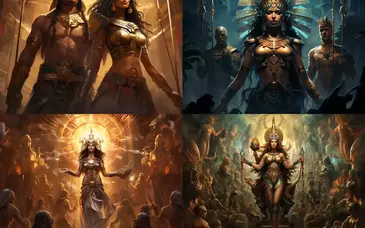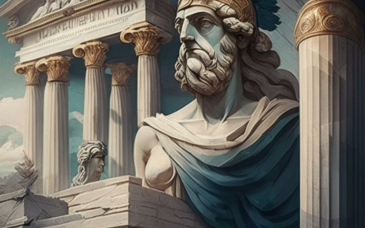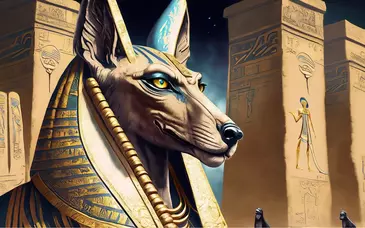The Deluge
The Legend
The legend of the Deluge, the epic flood that covered the world as punishment for mankind's wickedness is perhaps the most well-known legend in the world. The Biblical account of the Deluge states that "God saw that the wickedness of man was great" and resolved to destroy all of mankind. To this end torrents of rain poured down upon the earth for 40 days flooding the land so that only the peaks of the highest mountains were dry. However, God did spare the life of Noah as Noah was righteous and sought to live by God's law. God instructed Noah to construct a massive Ark to save himself, his family, and two of every animal that walked upon the land.
This is the story familiar to most, but the story of Noah is not the first of the legends of a global flood. Well before 2000 B.C. the Sumerians composed the Epic of Gilgamesh, a poem that detailed Gilgamesh's search for immortality. It is difficult to know how far back into antiquity the legend goes as Sumerian cuneiform, the first known form of writing, came into use about 3300 B.C. Before writing the legend was passed down orally from generation to generation.
Gilgamesh was a king of Uruk (Biblical Erech). According to the Sumerian Kings List he was the fifth king of the First Dynasty of Uruk and has been dated to circa 2600 B.C. According to the poem, Gilgamesh was one-third man and two-thirds god as his father was the god Lugalbanda. Gilgamesh is a poor and oppressive ruler who seduces women, takes away their children, and spends too much time building walls.
The people appeal to the gods for help. The gods create the wild man, Enkidu, to balance out Gilgamesh. Enkidu is created in the wilderness. He is a wild man covered with shaggy hair who spends time with the animals eating and drinking with them. He rouses the attention of a local trapper when he begins to free trapped animals. The trapper sends his son to Uruk to tell Gilgamesh of the wild man and to bring back a harlot. The harlot seduces Gilgamesh and teaches him the ways of civilized man causing the animals to reject him. The harlot also tells Enkidu of the great strength of Gilgamesh. Enkidu endeavors to meet Gilgamesh and enter into a contest of strength with him.
Gilgamesh and Enkidu meet and struggle with Gilgamesh eventually prevailing. Enkidu comes to respect Gilgamesh and the two become friends. Gilgamesh yearns for a legacy that will be remembered through all the generations that follow. To accomplish this Enkidu and Gilgamesh travel to the cedar forest to slay its guardian monster, the terrifying Khumbaba. Once in the forest they cut down a tree to draw out Khumbaba. They fight and Khumbaba loses. He begs for his life, but it is to no avail as Gilgamesh and Enkidu cut off his head.
Gilgamesh's exploits attract the attention of Inanna, the goddess of love. Inanna desires to marry Gilgamesh, but Gilgamesh refuses her offer and instead insults her and refers to her treatment of her previous husbands1. Inanna is hurt and pleads to her Father, Anu, to send the Bull of Heaven to punish Gilgamesh for his insolence. She threatens to open the Gates of Hell if Anu refuses, so Anu relents and sends the Bull of Heaven. Enkidu catches the Bull of Heaven by its horns and kills it.
Inanna becomes enraged and demands the death of Gilgamesh, but Gilgamesh is part divine and protected by Utu, the Sumerian god of justice. Instead the gods decide to punish Enkidu causing him to become ill and die. Gilgamesh becomes distraught over the death of Enkidu and also comes to the realization that his own death is inevitable.
Fearing his own death, Gilgamesh decides to seek out Utnapishtim, who is the only human to be granted immortality by the gods. He enters into the land of the gods where he meets Siduri, a divine maker of wine. Siduri offers shelter to Gilgamesh and advises him to accept his fate as a mortal and to enjoy his life. Gilgamesh refuses and insists upon finding Utnapishtim, so Siduri tells him that the boatman, Urshanabi, can ferry him across the River of Death to the place where Utnapishtim lives.
Gilgamesh meets with Utnapishtim and his wife. Utnapisthim tells Gilgamesh the story of the flood and how he survived. Enlil became angered with mankind and decided to send a flood to destroy them all. Enki, however, warned Utnapishtim of the gods plans and instructed him to build a boat to save himself, his family, friends, artisans, precious metals, and the animals.
What I had, I loaded thereon, the whole harvest of my life
I caused to embark within the vessel; all my family and relations, the beasts of the field, the cattle of the field, the craftsmen, I made them all embark.
I entered the vessel and closed the door....
When the young dawn gleamed forth from the foundations of heaven a black cloud arose; Adad roared in it, Nabu and the King march in front....Nergal seizeth the mast, he goeth, Inurta leadeth the attack...The tumult of Adad ascends to the skies.
All that is bright is turned into darkness, the brother seeth the brother no more, the folk of the skies can no longer recognize each other.
The gods feared the flood, they fled, they climbed into the heaven of Anu, the gods crouched like a dog on the wall, they lay down....for six days and nights wind and flood marched on, the hurricane subdued the land. When the seventh day dawned the hurricane was abated, the flood which had waged war like an army; The sea was stilled, the ill wind was calmed, the flood ceased.
I beheld the sea, its voice was silent and all of mankind was turned into mud! As high as the roofs reached the swamp! I beheld the world, the horizon of sea; Twelve measures away an island emerged; Unto mount Nitsir came the vessel, mount Nitsir held the vessel and let it not budge...
When the seventh day came I sent forth a dove, I released it; It went, the dove, it came back, as there was no place, it came back. I sent forth a swallow, I released it; It went, the swallow, it came back, as there was no place, it came back. I sent forth a crow, I released it; It went, the crow, and beheld the subsidence of the waters; It eats, it splashes about, it caws, it comes not back.
When the rains subsided Utnapishtim stepped out onto land and made a sacrifice to the gods. Enlil felt guilty for what he did and bestowed immortality upon Utnapishtim and his wife for their part in saving mankind, but they were to be confined to the island of Dilmun to spend all eternity in isolation. Enlil also promised to never again flood the lands.
Utnapishtim's wife takes pity on Gilgamesh and pleads with her husband to reveal to Gilgamesh the location of a plant that will prolong life. Gilgamesh dives into the sea to find the plant. He locates it and brings it back with him, but loses it while bathing when a snake sneaks up and eats it.
The Epic of Gilgamesh was first discovered in the library of King Assurbanipal of Nineveh. The find dates back to the 7th century B.C. and is written on twelve tablets. The first eleven tablets detail Gilgamesh's quest for immortality and the twelfth is a description of the Nether World. Gilgamesh came rule the Nether World after his death and was the divine judge over the shades. The find from Assurbanipal's library is the only near complete version found to date.
The poem originated in Sumer, but was later adopted by the Akkadians and Babylonians with each adding slight modifications. It is probable that the Hebrew account of the flood involving Noah originated from their captivity in Babylonia where they would have come into contact with the legends surrounding Gilgamesh.
1. A tradition in ancient Sumer involved a king's marriage to Inanna. A king who wished to become "King of Kish" and thereby assert his rule over all of Sumer would take part in ceremony in which he would marry Inanna, the Sumerian goddess of love and fertility.
The Facts
The evidence for a global flood and Noah's Ark has eluded historians for centuries. Many have spent years searching for the remains of Noah's Ark, with some claiming success. Recently, however, two marine biologists from Columbia University put forth a theory that has become accepted by many mainstream historians.
After years of research William Ryan and Walter Pitman introduced their theory that a sudden flood of the Black Sea occurred circa 7,500 years ago. About 12,000 years ago as the last ice age was coming to an end the Black Sea was a freshwater lake about two-thirds its current size and was separated from the Mediterranean by a narrow strip of land. Settlers took advantage of the freshwater to create farming communities surrounding the lake. As the ice age ended the ice sheets covering the northern hemisphere melted causing the water levels of the oceans to rise.
The rising waters of the Atlantic Ocean caused the water level of the Mediterranean to rise up to the edge of the Bosporus Valley. The only thing separating the Mediterranean and the Black Sea was a strip of land about 400' high and two miles wide. Eventually the wall succumbed to the pressure and burst. Salt water rushed through the gap rushing through Turkey and hit the Black Sea with an estimated force of 200 times greater than Niagara Falls.
The incoming salt water would have had several devastating effects on the area. The water level of the Black Sea would have risen about six inches per day. Those fleeing would have had to move 1/4 of a mile to one mile per day. The rising waters flooded coastal farms and killed thousands of people and animals. Agriculture was devastated as the salt water killed crops and the freshwater species of the lake. After two years the water level rose 400' flooding about 60,000 square miles of land. The memory of such a devastating flood would have been forever remembered by the survivors. Oral stories would have been passed down through the generations eventually attributing the flood to the will of their gods.
Pitman and Ryan's theory was given credence with the investigation of Robert Ballard. Ballard's research uncovered evidence that a flood of the Black Sea did occur about 7,500 years ago. The exploration of the Black Sea waters uncovered the wooden frame of a building as well as stone tools, including an ax. Four shipwrecks have been located, each well preserved due to the oxygen-depraved waters at the bottom of the Black Sea. Beneath 550' of water an ancient coastline with a flat beach area was found. Radiocarbon dating of sediments and shells from the beach area affixed the flood to circa 5500 B.C.






